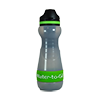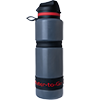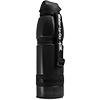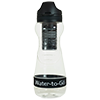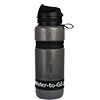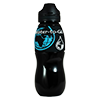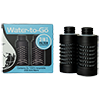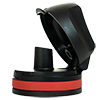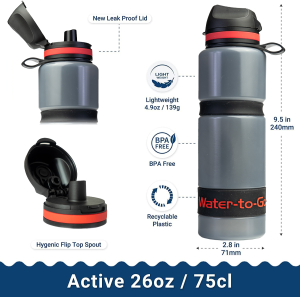Frequently asked Questions
What are Total dissolved solids (TDS) and are they harmful ?
Total dissolved solids (TDS) are the amount of organic and inorganic materials, such as metals, minerals, salts, and ions, dissolved in a particular volume of water; TDS are essentially a measure of anything dissolved in water that is not an H2O molecule. So not all TDS is bad!
What is the recommended daily water consumption?
The World Health Organisation (WHO) recommends we drink two litres of water per day. Our 200-litre filter (all bottles) will last for 100 days or three months if you drink two litres a day using the filter.
What is the shelf life of a brand new filter?
Without activating the filter, in the original packaging, our filters will have a ‘shelf life of three years.’ The nanotechnology in our filters is activated by contact with water, therefore before use, it is important to keep filters in a dry place
Can the filter be frozen?
No, the filter will not work effectively if it is frozen. If the filter does get frozen, make sure that is it fully defrosted (by filling the bottle with tepid water) before using it again. You can still fill the bottle with snow, ice etc and use the bottle to cold climates but it is important to ensure the filter doesn’t get frozen by keeping it in a bag, sleeping bag, close to your person etc.
How long do the filters last?
What makes Water-to-Go different from everything else?
Water-to-Go filters combine 3 different technologies to eliminate up to 99.9999% of all microbiological contaminants including viruses, bacteria, chemicals and heavy metals from any non-saltwater source in the world. Our cutting edge technology, as well as our price per litre (7p), makes Water-to-Go unique and different to everything else on the market. Learn more here
How do you activate the filter?
The filter must be wet thoroughly to activate the technology; drinking before the filter is fully wet can lead to unfiltered water passing through the membrane. We suggest the first time you use a new filter to fill the bottle up and turn it upside down, submerging the filter for a minimum of 15 minutes. Learn more here.
What should I do with the filters once I have finished with them?
The Water-to-Go filters are 100% recyclable so you can dispose of them sustainably. The casing and end caps can go in your plastic recycling, and the grey membrane can then go on your compost heap and biodegrade. Learn more here.
How does it work?
Water-to-Go uses three different technologies forged together in one filter to filter up to 99.9999% of all contaminants in water. The membrane used in the filter was developed from technology originally designed for NASA’s space program. This consists of:
A) Filter membrane with one of the smallest pores sizes ever developed for water filtration
B) The traditional technology of activated carbon particles (that reduce bad taste and odours) used within the filter membrane so that it is much more effective as there is less adhesive holding the carbon in place thereby providing a greater surface area for the carbon to work
C) The membrane releases a positive hydrostatic charge when it comes into contact with the water
No other water filter technology combines these three technologies and delivers results at low cost.
Learn more here
What are the three technologies Water-to-Go uses?
1) Water-to-Go uses mechanical filtration; a very small pore size which stops contaminants passing through.
2) Electrical (by a positive charge) which reduces the pore size even further and attracts the contaminants like a magnet would, trapping them inside the filter.
3) Finally our filters use carbon but instead of using adhesives to glue the carbon particles together, (which vastly reduces the carbon’s efficiency) it is contained within the membrane, helping to reduce contaminants whilst eliminating bad tastes and odours.
Try filtering water from your domestic filter and taste the difference!
Learn more here
Can you brand the bottles for charities and companies?
Yes, we can create bespoke bottles featuring your logo. We work with organisations and charities of all sizes to provide customised, branded products. All branded orders require a minimum order quantity of 500 band sets. For more information please contact info@watertogo.international

Are Water-to-Go products BPA-free?
Yes; all the product components (bottles, lids and filters) are BPA free and all materials used are approved by the FDA (Food and Drug Administration) in the USA. Our core guiding principles (see Our Mission.) are to protect people and the planet.
Can I put my bottle in the dishwasher?
The following items are dishwasher safe:
Note: Classic Go 50cl bottles are not dishwasher safe — please hand-wash these instead.
For all bottles, always remove the filter before cleaning.
What is the pore size of the filter (in microns)?
When we talk about pore size we refer back to standard technology. The mechanical restriction of the size of the pores has been the traditional measure of what a filter will eliminate. This is not the case with Water-to-Go. We have a unique combination of three technologies, each performs individually but it is the combination that makes us unique. We have a combination of two nano technologies, which not only reduce the pore size to 0.7 microns, but also create a positive hydrostatic charge in the membrane which attract and traps even the smallest of viruses like polio (which can be as small as 0.03 microns). Have a look at our testing page to see our tests for the Polio Virus – Testimony to the fact that we achieve substantial results by the combination of technologies rather than depend on just the mechanical calculation via a limited pore size.
Will the filter clean urine?
Whilst the filter could be used to filter urine in extreme emergencies, Water-to-Go strongly recommends against filtering and consuming urine.
Furthermore, Water-to-Go filters are intended to remove contamination from water. Filters will become inefficient if used with additives such as isotonic powders, cordials, juices etc.
What are the dimensions and weight of the bottles?
The bottles are very compact and aren’t too bulky so should fit in standard backpack side pockets and standard bike racks or cages. The 75cl eco active bottles are 24cm high and 7.1cm wide at the base. Weighing only 138g (empty with dry filter). Our new 1 litre bottles are 27.5cm high and 7.9cm wide at the base, weighing 185g (empty with dry filter).
Do you have testing reports?
Yes. You can view these on our website, We have been tested on three continents by internationally renowned laboratories in London, Florida, Bangalore and China.
We have further test results coming in from additional laboratories in Europe.

How much per litre would water cost via your bottles?
A twin pack of filters is £27.99 and provides 400 litres of filtration. This means the cost per litre is £0.069.
How does the bottle ‘save the planet’?
By choosing a Water-to-Go bottle, you help reduce plastic pollution and save natural resources. Millions of single-use plastic bottles end up in our oceans, harming wildlife and damaging ecosystems.
Making just one Water-to-Go bottle instead of 100 single-use bottles conserves valuable resources, huge amounts of oil, water, and other materials are consumed in producing and shipping disposable bottles. Yet, only 12% of plastic bottles are ever recycled.
Our eco range is now made from plant-based materials such as sugarcane waste and recycled vegetable oil, replacing fossil fuel–based plastics.
We conservatively estimate we have replace over 220,000,000 single use plastic water bottles.
Do you filter Chlorine and Fluoride?
Yes. Recent tests show that Water-to-Go filters reduce the amount of chlorine in the water to below detectable levels. Our filters use both alumina nano technology and carbon to filter out fluoride. You can see our testing results, also you can taste the difference when you drink from a Water-to-Go filtered water bottle.
How do I know when my filter needs replacing?
There are two ways to know when to change your filter:
-
Email reminder – If you’ve signed up for our newsletter, we’ll email you after three months (based on drinking 2 litres a day) reminding you to change your filter.
-
Taste and smell change – One of the three filter technologies is carbon, which we programme to last for 200 litres. After this point, the filter will still remove bacteria, cysts, and harmful contaminants, but the water will gradually return to its original taste and smell. This is your sensory prompt to replace the filter.
If I don’t use my bottle everyday will it still only last for 2-3 months?
No, the lifespan of the filter is based on the amount of water it filters, not how long it has been in use.
If you haven’t used your bottle for a while and the filter has dried out, you’ll need to reactivate it:
-
Fill the bottle and turn it upside down so the filter is submerged for 15 minutes.
-
Gently squeeze out the water until it runs clear.
We’ve created a short video to show you how to reactivate your filter.
Is it ready to go?
Yes. All you need to do is ensure the filter is wet through and flush once to activate it. We suggest the first time you use a new filter you fill the bottle up and turn it upside down, submerging the filter for 15 minutes. Then gently squeeze out the contents until the water runs clear.
We have created a short video showing how to activate your filter.

